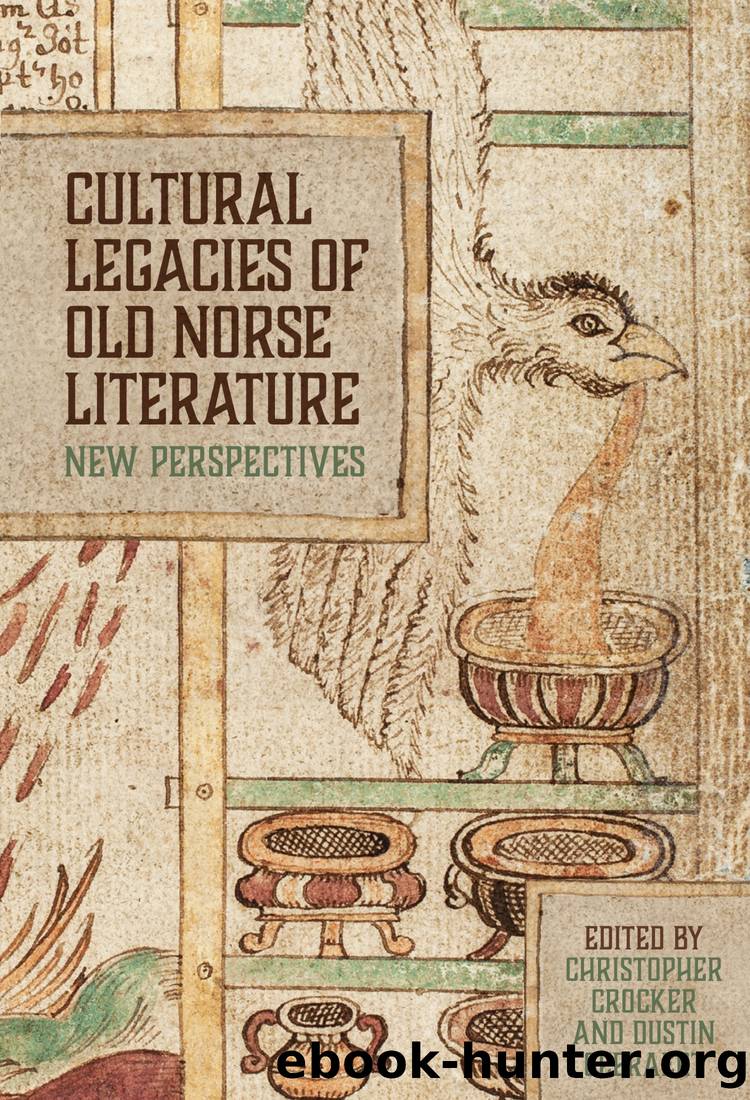Cultural Legacies of Old Norse Literature by Dustin Geeraert;Christopher Crocker;

Author:Dustin Geeraert;Christopher Crocker; [Crocker;, Dustin Geeraert;Christopher]
Language: eng
Format: epub
ISBN: 9781843846383
Publisher: Boydell & Brewer
Published: 2022-08-23T00:00:00+00:00
Kingsâ Sagas
John McKinnell has directed attention to the dual nature of how the Odinic is expressed, especially noting how the invocation of his name or presence can be made in a sympathetic or unsympathetic manner.54 For unsympathetic examples, McKinnell points to Oddur Snorrasonâs Ãláfs saga Tryggvasonar, Ynglinga saga, the prologue of the Prose Edda and Gautreks saga. In Ynglinga saga, it is said that Ãðinn was followed by twelve leaders in the magic arts and that these höfðingjar (magnates) received sacrifices from others and were called their gods.55 The Prose Edda makes mention of those who lost their way from God and worship things such as celestial objects. Gautreks saga, however, appears the least forgiving of all these sources, where people who live in the forest of western Gautland throw themselves from a precipice to appease Ãðinn, hoping to find life in Valhalla. The patriarch of this family wears a wide-brimmed hat and lets the brim droop over one eye, representative of the one-eyed Ãðinn. However, wisdom appears to be lacking in this family, as the tone of the scene suggests that this is a representation of a people who are completely lost.56
For the sympathetic view, the Odinic is intermingled with mistaken identity, or at the very least a shroud of mystery. In the early thirteenth-century kingsâ sagas found in the manuscript called Morkinskinna, there is an Odinic figure in Magnúsar saga góða, where an old blind man in a hat hinders Magnús from having a sexual affair with Margrét Ãrándardóttir.57 Another sympathetic account of an Odinic figure appears in connection with a king, this time Ãlafur Tryggvason, in an episode of a later manuscript from the late fourteenth-century Flateyjarbók, referred to as âHalldórs þáttr Snorrasonarâ.58 A grÃmumaður (masked man) appears to purchase Einar Ãambarskelfir and his comrades out of slavery. In return, Einar is required to come to the aid of another man at some point in the future. The grÃmumaður not only points to the Odinic in his name (obvious connections can be made with the name GrÃmnir, meaning âMasked Oneâ), but in his clothing and behaviour as well. The figure calls up images of Ãðinn from GrÃmnismál venturing into the lands of men to bring favour to those who deserve his appreciation because of their acts toward their fellow man. This is a parallel to the above-mentioned poem Hávamál.
Halldór gets into trouble at the outset of this rendition of his tale because he is offended by the behaviour of another, becoming his killer.59 Einar aids Halldór in the matter and offers up a story as his reason. The story is a mysterious one, taking place during the aftermath of the Battle of Svolder. The legendary naval vessel, Ormurinn langi (The Long Serpent), is lost, and Einarr is taken to be sold into slavery. The mysterious grÃmumaður appears, a great man in a long cowl with a mask upon his face who purchases three men and without counting his money drops it into the slaverâs lap. The fetters are loosed from the men and the masked man wanders away into the forest.
Download
This site does not store any files on its server. We only index and link to content provided by other sites. Please contact the content providers to delete copyright contents if any and email us, we'll remove relevant links or contents immediately.
4 3 2 1: A Novel by Paul Auster(11791)
The handmaid's tale by Margaret Atwood(7449)
Giovanni's Room by James Baldwin(6810)
Asking the Right Questions: A Guide to Critical Thinking by M. Neil Browne & Stuart M. Keeley(5356)
Big Magic: Creative Living Beyond Fear by Elizabeth Gilbert(5352)
Ego Is the Enemy by Ryan Holiday(4958)
On Writing A Memoir of the Craft by Stephen King(4664)
The Body: A Guide for Occupants by Bill Bryson(4584)
Ken Follett - World without end by Ken Follett(4444)
Bluets by Maggie Nelson(4261)
Adulting by Kelly Williams Brown(4235)
Eat That Frog! by Brian Tracy(4149)
Guilty Pleasures by Laurell K Hamilton(4117)
White Noise - A Novel by Don DeLillo(3829)
The Poetry of Pablo Neruda by Pablo Neruda(3816)
Fingerprints of the Gods by Graham Hancock(3738)
Alive: The Story of the Andes Survivors by Piers Paul Read(3730)
The Book of Joy by Dalai Lama(3698)
The Bookshop by Penelope Fitzgerald(3619)
